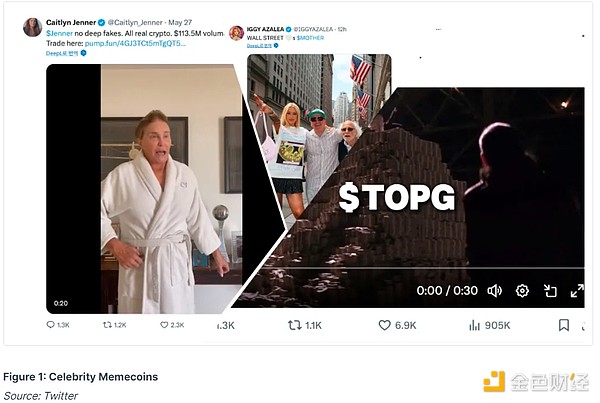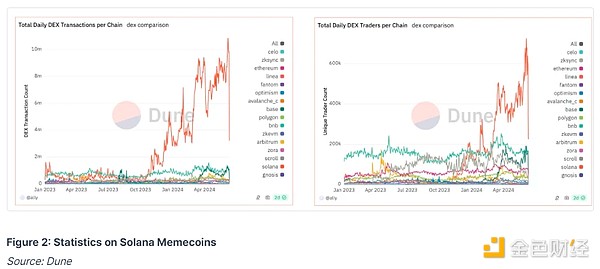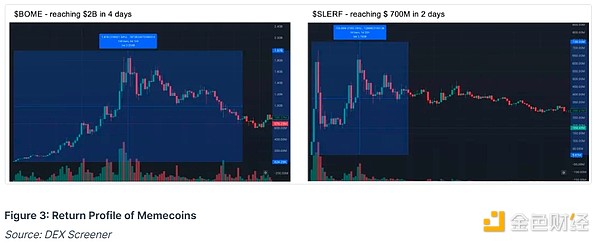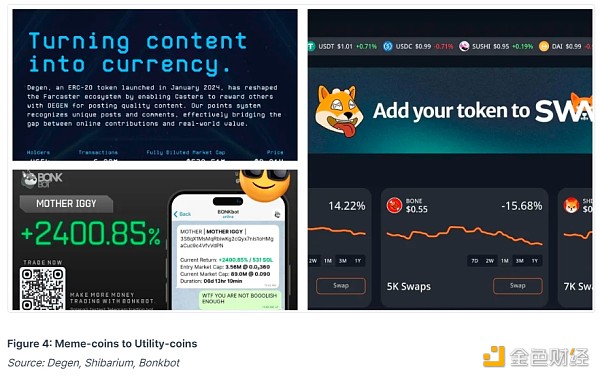Author: Min Jung, Presto Research; Compiler: Deng Tong, Golden Finance
Summary
The rise of memecoins on Solana has accelerated thanks to accessible platforms such as pump.fun, Bonkbot, and Photon, which allow trading and token creation without programming skills. In May alone, Solana saw the creation of 455,000 new memecoins, attracting a large amount of daily trading activity, and platforms like pump.fun generating millions in fees.
Memecoins have thrived due to their superior return potential, their role as an easy entry point into the cryptocurrency market for ordinary people, and their ability to build strong communities, which are critical for any business.
However, the memecoin market remains subject to widespread manipulation by influential insiders, exacerbated by minimal regulatory oversight on decentralized exchanges.

Love them or hate them, memecoins are one of the hottest areas in both crypto and traditional finance. GameStop has seen another major surge with the return of Roaring Kitty, whose livestream attracted nearly a million viewers, easily surpassing the FOMC audience. In the crypto space, countless memecoins have been created, from celebrity memecoins like $JENNER to $RNT, some of which have reached a $1 billion market cap in a matter of days. With this in mind, this article aims to outline the current state of Memecoins and explore why they continue to exist.
Current Situation
With tools like pump.fun, Bonkbot, and Photon, memecoin trading has become easier, making it easier for people to trade and create tokens. Platforms like pump.fun allow individuals with zero coding knowledge to create tokens without having to worry about providing their own funds to liquidity pools (LPs), while various bots including Bonkbot and Trojanbot make it easy for people to trade memecoin from their mobile phones.
Due to low gas fees and fast transaction confirmations, 455,000 memecoins were created on Solana in May alone, attracting an average of 600,000 DEX traders per day and generating 10 million DEX transactions per day. With more memecoins created, Pump.fun generated $3.3 million in revenue in just seven days, surpassing Uniswap's weekly revenue. Even blockchain foundations are turning their attention to memecoins, recognizing that they are now critical to their ecosystems; for example, the Avalanche Foundation announced their memcoin fund in March, and Base founder Jesse Pollak is promoting $BRETT, recognizing that memecoins are critical to the layer ecosystem.
With a large number of memecoins being created every day, the meta is constantly evolving. The hottest meta today is the celebrity memecoin trend, which started with Caitlyn Jenner and Iggy Azalea. At one point there was a trend of "~ on Sol" (e.g., $BTC on Sol, $ETH on Sol), and just last week over 1,000 memecoins were themed after Andrew Tate.Of course, most of these tokens will eventually go to zero, leading to a new phenomenon called "CTO (community takeover)", where developers abandon the project and the remaining community members take over its development.

Why do they persist?
In today's world, what product can reach $250 million or even $1 billion in a week from scratch? Probably only memecoins. Whether memecoins are useful or not, from a purely investment perspective, they are a compelling addition to a portfolio. During the Consensus 2024 conference, Asymmetric Capital CEO Joe McCann suggested that allocating 2-3% of a portfolio to memecoins could offer significant upside, at least in the current market. Whether positive or negative, 100x returns are common in the memecoin space, and there is no doubt that memecoins are something investors and portfolio managers should consider including in their portfolios.

A Good Choice for “Ordinary People”
Even for those who are new to cryptocurrencies, they may have heard of Dogecoin and Shiba Inu. For many people, Dogecoin is likely the first thing they buy when entering the cryptocurrency market, rather than choosing more complex options like ZKSync and learning what ZK rollup is. While it may seem silly, memecoins actually provide a gateway for newcomers to enter cryptocurrencies by driving mass adoption. For example, Elon Musk tweeted about Dogecoin and discussed it on SNL, which brought a lot of attention to the entire asset class. Additionally, memecoins are actively promoted through sports partnerships (e.g. $FLOKI) and by raising advertising on platforms like Sphere (e.g. $WIF) to attract a general audience, helping the mass adoption process. This success is partly because memecoins are “cute and silly.” Would it have attracted the same level of attention if Elon Musk had mentioned the ZK rollup project on SNL? The most important factor in the success of memecoin is a strong community. Looking at successful Web2 startups, most started with a community, like Reddit. For example, Instagram and Facebook started out with no revenue model, but eventually launched advertising because they had already built a “community.” The success of a business often depends more on its community than the technology itself, because once there is a strong community, any business can easily build on top of it. This is exactly what is happening with memecoin today. Bonk, which was initially considered a “fake Doge”, now has Bonkbot, which has generated $65 million in fees. Similarly, Shiba Inu is creating a Layer 2 solution called Shibarium. Although memecoin may seem “useless” at first, it can scale in different ways while building a successful community. Therefore, criticizing memecoin with a strong community for not having utility is like accusing early Facebook and Instagram of not having a revenue model.

However…
Yes, of course, the memecoin market still has many problems. It is a highly manipulated market, prices can be driven by certain whales and insiders, and can be easily manipulated with minimal resources. On top of that, since trading mainly takes place on decentralized exchanges, there is little regulation. This leads to frequent rushes on DEXs, where only a few of the thousands of tokens survive in the coming months. Therefore, we must establish higher ethical standards and regulations to prevent these behaviors.
 Alex
Alex
 Alex
Alex Hui Xin
Hui Xin Joy
Joy Kikyo
Kikyo Brian
Brian Joy
Joy Hui Xin
Hui Xin Joy
Joy Alex
Alex Kikyo
Kikyo